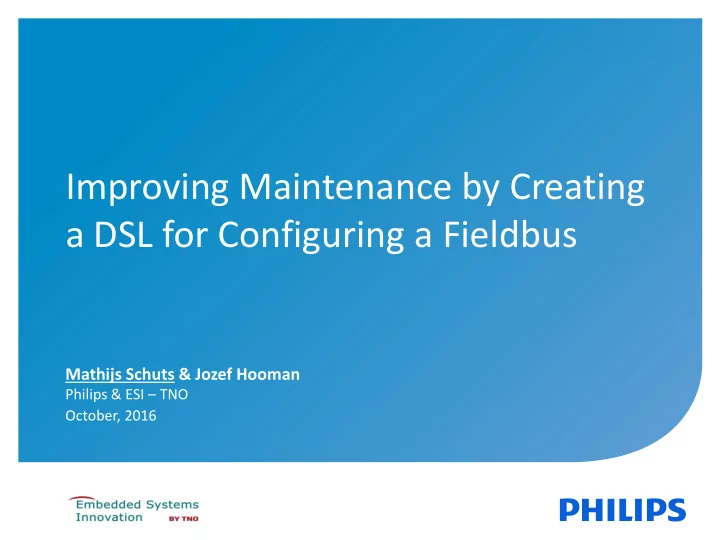

Improving Maintenance by Creating a DSL for Configuring a Fieldbus Mathijs Schuts & Jozef Hooman Philips & ESI – TNO October, 2016 1
Software Life Cycle • Different component in a high-tech system have different life cycle • Some component are legacy • Maintenance effort 50- 75% of SLC K. Bennett and V. Rajlich, Software Maintenance and Evolution: Roadmap 2
DSLs for Improving Maintenance of Legacy Components • Is it financially feasible to extend the life of a legacy component using a DSL? • What are the pros and cons of using a DSL compared to the current way of working? 3
Allura Xper • Interventional X-ray – Minimal invasive treatments • Treatment of – Cardio, and – Vascular diseases 4
Building Blocks • Customer can configure system • Patient tables – 1-6 motorized axes • Stands – Ceiling – Floor • Stand mover 5
Fieldbus Topology 6
Fieldbus Topology • Topology descriptions for the master are made with a commercial tool • Creating topology files is an error-prone time consuming activity • Hardware set-ups need to be created to test the topology files 7
DSL for Fieldbus Configurations 8
Checking the Topology Validation rules: • No two branches connected to the same port of a node • Topology names are unique • TYPE_A1 and TYPE_A2 are both present or not present • TYPE_A2 is connected to TYPE_A1 9
DSL to Describe System Configurations • In the future we need 2000 topology files • A system release needs to contain support of all possible configurations, hence topologies 10
DSL to Describe System Configurations 11
Concluding Remarks • Is it financially feasible to extend the life of a legacy component using a DSL? – Return on Investment (ROI) = (gain from investment – cost of investment) / cost of investment Gain: 2000 topologies * 8 hours = 16000 Investment: 50 hours current DSL + 20 hours add support new vendors + 20 hours to create instances = 100 ROI = (16000 - 100) / 100 = 159 12
Concluding Remarks (cont’d) • What are the pros and cons of using a DSL compared to the current way of working? • Advantages: – DSL is simple and easy to use – Faster – Because of validation rules, less error prone than current way of working • Disadvantages: – Generator’s code need to be maintained – Generators are programmed in Java/Xtend while C++ is preferred programming language – Used IDE is Eclipse while the preferred IDE is Microsoft Visual Studio 13
Concluding Remarks (cont’d) • High ROI indicates that the investment in the DSL will be preferred above the current way of working • At Philips we applied DSLs on multiple other cases • Given this and other experiences, we continue to use DSLs 14
Q&A 15
16
Recommend
More recommend